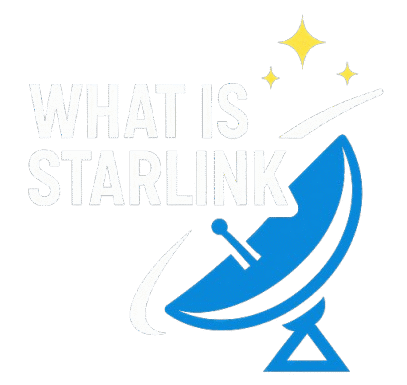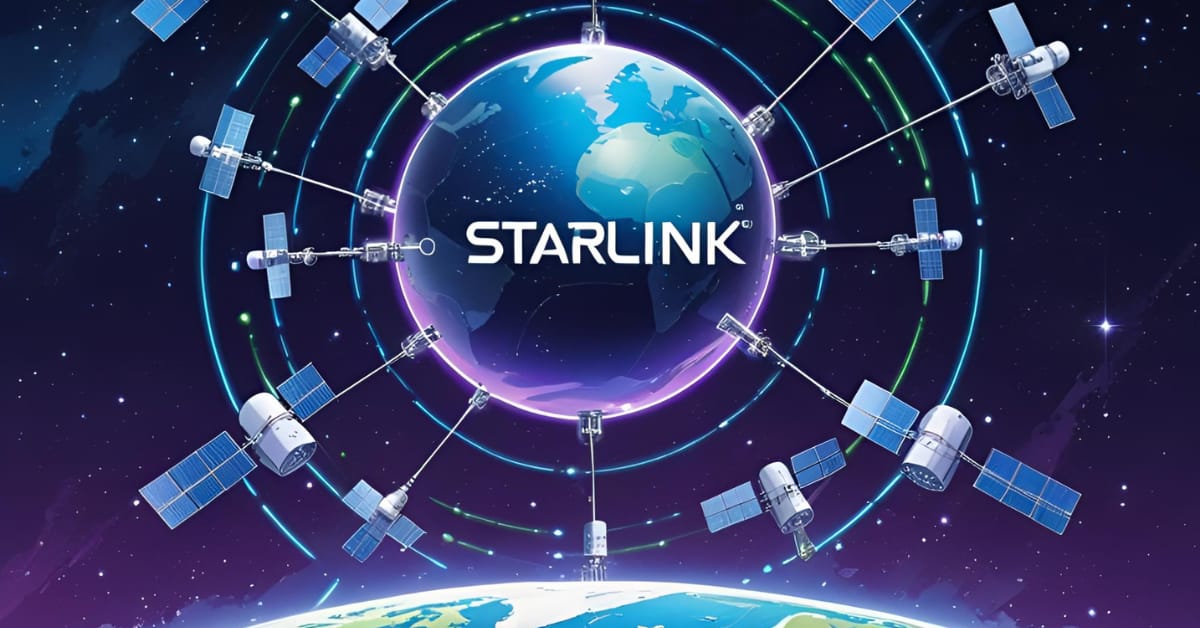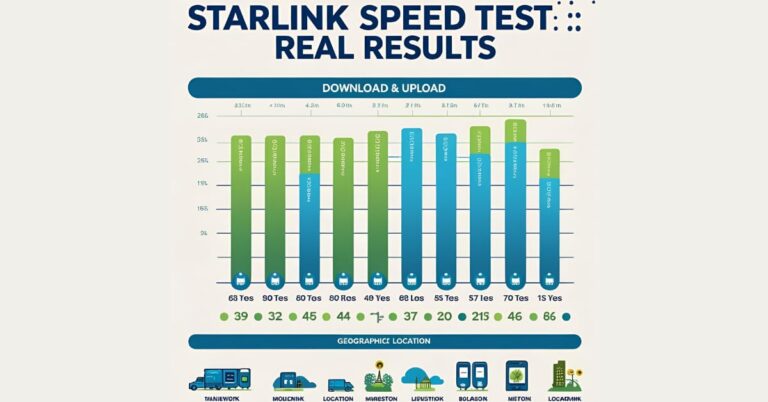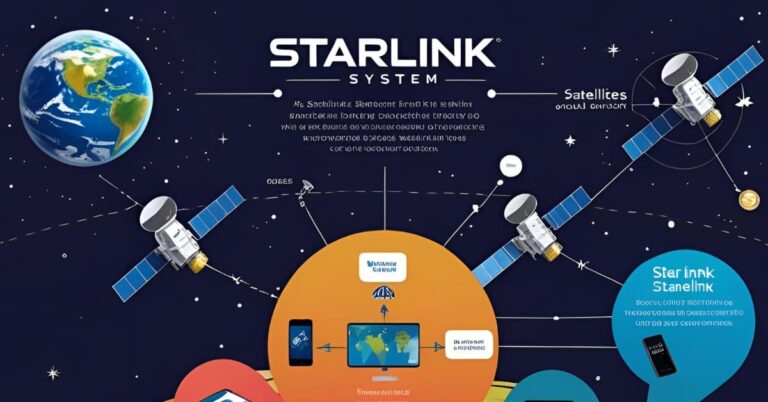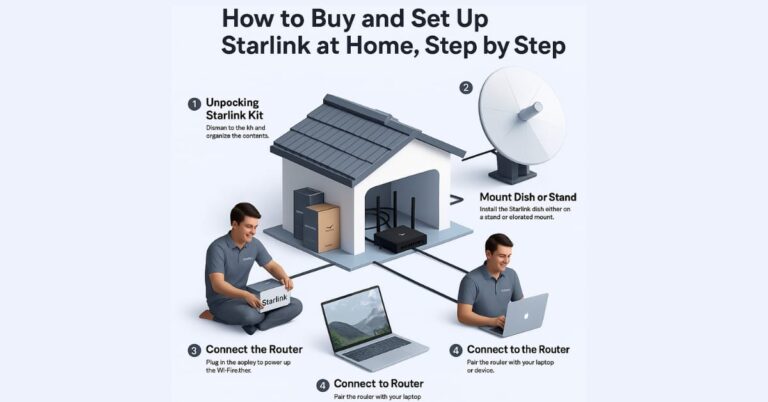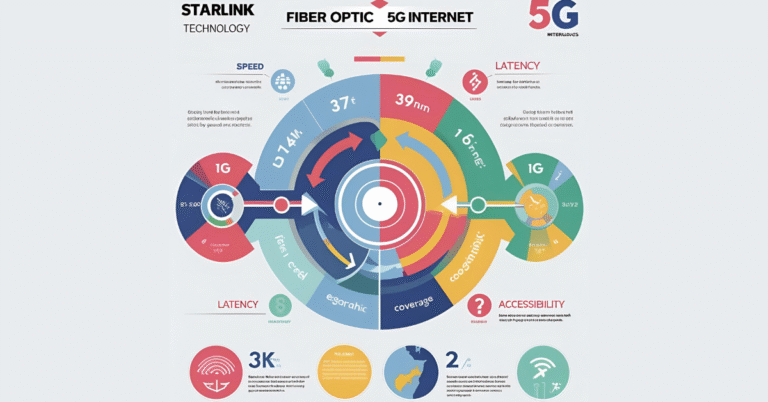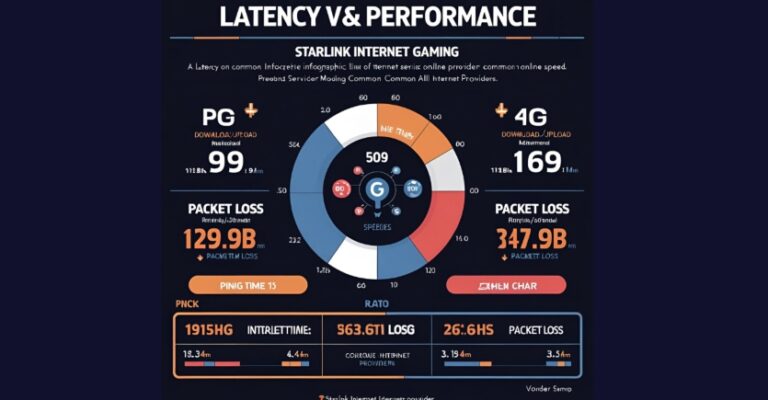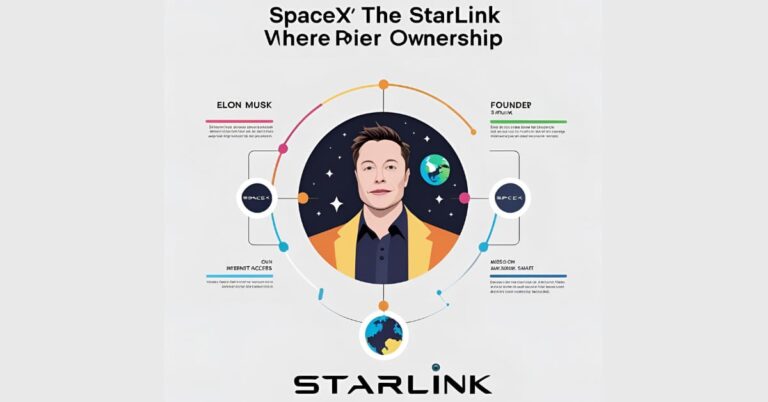Starlink Satellite Internet: The Future of Global Connectivity
Picture a world where high-speed internet is a right for everyone. It streams easily into remote villages, distant islands, and deep forests. This isn’t a scene from a sci-fi movie. It’s the bold vision of Starlink, SpaceX’s satellite internet service, becoming a reality fast.
Reliable internet access has been key for economic growth, education, and social connections for decades. However, many parts of our planet are still underserved and in a digital divide. Traditional infrastructure is hard to set up or too costly. Now, Starlink enters the picture. It promises to change our world and how we connect, all from space.
How Starlink Works: The Innovation Orbiting Above You
Forget everything you know about conventional satellite internet. Those systems usually depend on a few large geostationary satellites, which orbit thousands of kilometres above Earth. Starlink uses a vast network of Low-Earth Orbit (LEO) satellites. Many agile satellites circle Earth at 550 kilometres, and more are being launched. This crucial difference is the secret sauce behind Starlink’s jaw-dropping performance.
When you send a request with your sleek Starlink dish, it connects fast to the nearest LEO satellite. This satellite works like a relay runner. It sends your data to a ground station connected to the Internet’s backbone. Newer satellites can now send data directly to each other. They use optical inter-satellite links, also known as space lasers. This technology creates a global mesh network in the sky. This game-changing web in space cuts down the round-trip time for data, called latency. Old-school satellite internet had slow latencies of 600 milliseconds or more. In contrast, Starlink offers latencies between 20 and 60 milliseconds. This puts Starlink in direct competition with many land-based broadband services.
Each Starlink satellite showcases brilliant engineering. It has a compact, flat-panel design and advanced phased-array antennas. Plus, it uses krypton-powered ion thrusters, which help avoid collisions and ensure precise orbital manoeuvres. SpaceX can launch its satellites with the powerful Falcon 9 rocket, upgrading, expanding, and strengthening the network.
Bridging the Digital Divide: A Game-Changer Arrives in Pakistan!
Starlink’s most profound impact isn’t just about speed but its potential to bridge the global digital divide. It is a lifeline for communities in remote areas, including rural places, isolated islands, and regions hit by disasters. Here, installing fiber optic cables or cell towers feels impossible.
- Empowering Underserved Communities: Picture a school high in the mountains of Pakistan using online learning tools. Also, think of a small business in a desert village linking directly to global markets. Starlink opens up new chances for learning, healthcare, and economic growth. It reaches areas that were once cut off from the digital world.
- Disaster Relief & Emergency Connectivity: Regular communication networks often fail during natural disasters. Starlink’s quick and self-sufficient network steps in. It offers vital connectivity for emergency responders, showing its value as a strong support system.
- Enabling Remote Work: This has accelerated the speed of work. However, many faced challenges due to slow internet. Starlink lets people and families live and work from nearly anywhere, encouraging a more flexible and spread-out workforce.
As of June 2025, Starlink service is available in over 110 countries. This is exciting. Exciting news for Pakistan! Starlink will likely launch its commercial services by November or December 2025.
Key steps are:
- Obtain a No-Objection Certificate (NOC).
- Stay updated with licensing from the Pakistan Telecommunication Authority (PTA).
This is a huge step that will improve digital access nationwide. It aims to address the ongoing digital divide in underserved areas.
Starlink vs. Traditional Internet: A Head-to-Head Battle
Starlink is a game-changer, but it’s essential to know its pros and cons compared to traditional internet services:
The Unbeatable Advantages of Starlink:
- Unmatched Coverage: It connects rural and remote areas in Pakistan. Other options are often slow, unreliable, or unavailable.
- High Speed & Low Latency (for Satellite): It offers speeds like mid-tier cable and has much lower latency than regular geostationary satellite internet.
- No Data Caps: Most residential Starlink plans offer glorious, unlimited data – a huge relief compared to many capped plans.
- Effortless Self-Installation: The user-friendly kit makes setup surprisingly straightforward.
- Incredible Portability: “Roam” plans let you take your internet anywhere. This is great for RVs, campers, and mobile businesses. It’s a significant advantage for travelling and the industry in Pakistan.
The Realities to Consider:
- Starlink has a higher upfront cost. The dish is about PKR 110,000 for homes in Pakistan.
- Monthly Subscription Cost: The fees for remote areas are competitive. But, at about PKR 35,000 for residential, they may be higher than cities’ bare fiber or cable plans.
- Weather Dependency: Heavy rain or snow can disrupt signals. This can happen even with a strong system.
- Clear Sky View Required: The dish needs an unobstructed sky view. Trees, buildings, or other tall structures can block the signal.
- Latency Still Higher Than Fibre: Starlink’s latency has improved dramatically, but it is still higher than the quick speeds of fibre optic broadband.
The Road Ahead: Navigating Challenges, Seizing Opportunities in Pakistan
Like globally, Starlink’s journey in Pakistan isn’t without its complexities. Regulatory hurdles, including finalising legal frameworks for spectrum allocation, national gateways, content monitoring, and local billing in PKR, are still being meticulously addressed. Astronomers worry about satellite light pollution and space debris. These issues are essential topics for SpaceX and are widely discussed worldwide.
However, the opportunities simply dwarf the challenges. SpaceX keeps pushing the limits. The new V3 Starlink satellites will offer higher capacity and fantastic performance. The Direct-to-Cell (DTC) service lets regular 4G LTE phones connect directly to Starlink satellites. This change is set to revolutionise mobile connectivity in remote areas. It will also be a significant force for transformation in Pakistan in the coming years.
Starlink’s imminent arrival in Pakistan is set to shake up the telecom sector. It should encourage current internet providers to improve their services and create a more competitive and lively market. The government is also promoting this competition. Other satellite internet providers, such as Shanghai Spacecom Satellite Technology in China, also seek licenses.
FAQs:
Q1: Is Starlink available for purchase in Pakistan right now?
A: As of June 2025, Starlink has not officially launched for commercial use in Pakistan. It’s in the final stages of regulatory approval and is expected to launch by November or December 2025.
Q2: What are the estimated costs for Starlink in Pakistan?
A: Based on current information, estimated costs are:
- Residential: Approx. PKR 35,000/month + PKR 110,000 one-time hardware fee.
- Business: Approx. PKR 95,000/month + PKR 220,000 one-time hardware fee.
- Mobility: Approx. PKR 50,000/month + PKR 120,000 one-time equipment cost. (These are estimates and may change upon the official launch.)
Q3: What kind of speeds can I expect from Starlink in Pakistan?
A: You can generally expect:
- Residential: 50–250 Mbps download.
- Business: 100–500 Mbps download.
- Mobility: 50–250 Mbps download. (Actual speeds may vary based on location and network conditions.)
Q4: Will Starlink have data caps in Pakistan?
A: Most residential Starlink plans globally offer unlimited data. Policies for Pakistan will be confirmed at launch. However, this model is expected to be followed.
Q5: How does the weather affect Starlink performance in Pakistan?
A: Starlink is robust, but heavy rain or snow can temporarily degrade the signal. The dish has a heating system to melt snow.
Q6: What do I need to install Starlink?
A: The kit usually includes the dish, Wi-Fi router, power supply, cables, and a mounting tripod. You’ll need a clear, unobstructed view of the sky. The Starlink app guides you through the setup.
Q7: Will Starlink’s Direct-to-Cell service be available in Pakistan?
A: Direct-to-cell is a future global development for Starlink. They haven’t shared the timeline for Pakistan yet. But this will significantly boost mobile connectivity.
Conclusion:
Starlink is not just an internet service. It shows how clever humans can be and helps connect the world. We push satellite technology to communicate when we are unconnected and in this place. This effort also changes what is possible in our interconnected world. The upcoming launch of Starlink in Pakistan is a key moment. It will change economies, improve education, and boost emergency response nationwide.
The future of global connectivity looks bright, and Starlink is at the forefront. They imagine a world where geography doesn’t block access to information. opportunities, or connections. Pakistan is on the brink of a significant digital change, and Starlink is set to play a key role in this exciting journey.
